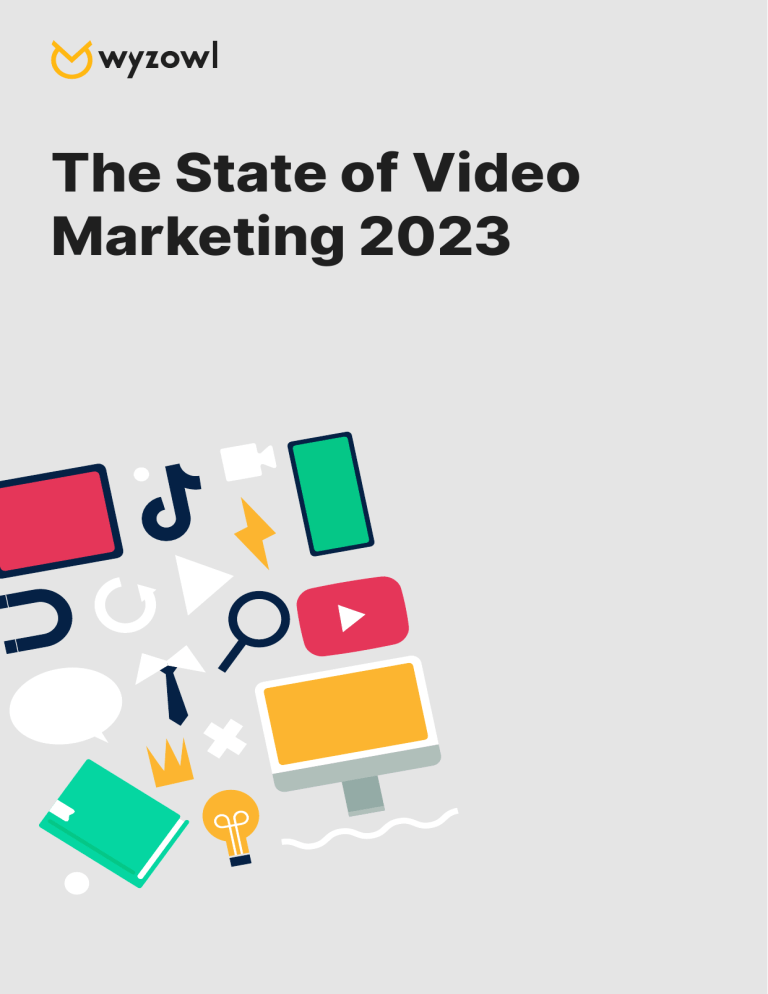
The State of Video Marketing 2023 Video Marketing Statistics 2023 Hey there! Thanks for downloading Wyzowl’s State of Video Marketing report. We hope you enjoy diving into the report as much as we enjoyed putting it together. We’ve included a ton of valuable information and insights that we hope will help you make even better decisions for your business. Thanks again for downloading and happy reading! This is the ninth year in a row that we’ve put this report together and it’s always so exciting to see how the video marketing industry has grown and evolved over time. When we first started this back in 2015, we never could have known we would still be tracking these trends - and seeing such growth - nearly a decade later! This year’s report is a fascinating read, if we say so ourselves - with some of the highest numbers we’ve seen in all nine surveys. Video marketing is definitely not showing any signs of slowing down - it’s here to stay and it’s only getting bigger and better. We gathered the video marketing statistics below by surveying 528 unique respondents in November 2022. Our sample included both marketing professionals and online consumers. We separated these groups with a preliminary question, ensuring that respondents were only asked to answer the questions relevant to them. Video Marketing Statistics 2023 Citation Policy: Please feel free to use these statistics in any commercial or non-commercial capacity. If you use the statistics we require a link to Wyzowl Section 1: Video Marketing Usage ‘Video’ is one big label for a LOT of different things. Animated, screen recorded, live action, and more. In our survey, we wanted to find out what types of video marketers were creating. Video continues to be used by an overwhelming majority of businesses. 91% of businesses use video as a marketing tool in 2023 This is an all-time high since we started tracking this data in 2016. The highest ever proportion of marketers (96%) continue to value video as an ‘important part’ of their marketing strategy. Video Marketing Statistics 2023 Reasons for not using video marketing… When we asked businesses which DON’T use video as a marketing tool, the main reason why this was the case, they answered as follows… 30% of people lack the time to create video content 18% of people don’t know where to start with creating video content 10% of people are unable to convince key decision-makers of the need to invest in video 10% of people feel that video is too expensive 8% of people don’t create video content because they don’t feel video is needed 5% of people are unclear they’ll get a good ROI from creating video content Video Marketing Statistics 2023 BUT... 70% of ‘non-videomarketers’ plan to start online video marketing in 2023 Video Marketing Statistics 2023 First time video marketers 17% of video marketers said they used video for the first time in 2022 When we asked marketers who used video for the first time in 2022, why they had decided to take the plunge, we received a wide variety of responses… 41% of marketers who used video as a marketing tool for the first time in 2022, said they were able to do so because it had become easier to create video inhouse. 39% of marketers who used video as a marketing tool for the first time in 2022, said they were able to do so because it had become easier to convince others in the business on the value of video content. 34% of marketers who used video as a marketing tool for the first time in 2022, said they were able to do so because it had become quicker and less time-consuming to create video. 30% of marketers who used video as a marketing tool for the first time in 2022, said they were able to do so because video has become more affordable than it used to be. Video Marketing Statistics 2023 22% of marketers who used video as a marketing tool for the first time in 2022, said they were able to do so because they had become clearer on the ROI of video. 20% of marketers who used video as a marketing tool for the first time in 2022, said this was at least partly because new video content was made necessary by new challenges. Our analysis… Video continues to be a widely used marketing tool – trusted by around 9 out of 10 businesses. To put it simply, more businesses are using video than at any point in the past 9 years. Reasons for not using video were split widely, but a lack of time was clearly the most commonly cited obstacle. Video usage looks set to increase still further in 2023, with current marketers almost unanimously planning to continue their video marketing efforts over the next 12 months – and 70% of current ‘non-video-marketers’ looking to get started. Video Marketing Statistics 2023 Section 2: Types of video created Our survey reveals that brands create a pretty even split when it comes to video style. 66% of video marketers created live action video in 2022. 57% of video marketers created screen recorded video in 2022. 55% of video marketers created animated video in 2022. Video Marketing Statistics 2023 We also got some interesting data surrounding the wide variety of different types of video marketers create… 71% of marketers created social media videos in 2022. 70% of marketers created explainer videos in 2022. 50% of marketers created presentation videos in 2022. 46% of marketers created testimonial videos in 2022. 46% of marketers created video ads in 2022. 42% of marketers created teaser videos in 2022. 40% of marketers created sales videos in 2022. 36% of marketers created product demo videos in 2022. 23% of marketers created videographics in 2022. 21% of marketers created customer onboarding videos in 2022. Video Marketing Statistics 2023 21% of marketers created customer service videos in 2022. 20% of marketers created staff training videos in 2022. 5% of marketers created app demo videos in 2022. 15% of marketers created new hire onboarding videos in 2022. Our analysis… Although social media marketing videos and explainer videos stand out at the top of the pile here, what’s notable is the sheer volume of different types of video used by businesses. A dizzying array of internal and customer-facing functions are being supported and enhanced through the use of video, which is great to see. Video Marketing Statistics 2023 Section 3: Video marketing – The financials Next, we wanted to understand how much businesses spend on video, and whether they feel those costs are changing over time. We asked how much brands might expect to spend on an average video… 42% of video marketers say they spend between $0 and $500 on an average video. 18% of video marketers spend between $501 and $1,000 on an average video. 25% of video marketers spend between $1,001 and $5,000 on an average video. 9% of video marketers spend between $5,001 and $10,000 on an average video. 3% of video marketers spend between $10,001 and $20,000 on an average video. 4% of video marketers spend more than $20,000 on an average video. Video Marketing Statistics 2023 We also asked whether marketers felt the costs associated with video marketing had changed. We got a very mixed response. 39% of video marketers feel video marketing is becoming more expensive. 26% of video marketers think video marketing is becoming less expensive. 35% of video marketers haven’t noticed any changes to the cost in the last year. Video Marketing Statistics 2023 Our analysis… It’s clear that a significant proportion of video marketers are embracing the increasing accessibility of inexpensive, even free, video marketing channels, with an overwhelming majority spending little or nothing on their typical video content output. Outside of this, where brands DO decide to spend more on their video, there clearly seems to be a sweet spot in that $1k-$5k per video ball park. But, as always, there’s a small but significant handful of brands willing to go further, and run a higher video marketing budget. Ultimately? Marketing video has a broad range of different price tags and is increasingly accessible to lots of different types of business. Video Marketing Statistics 2023 Section 4: ROI: What does success look like? How do video marketers judge ‘success?’ “You can’t improve what you don’t measure.” So we set out to understand the metrics marketers use to evaluate the success (or otherwise) of their video marketing efforts. 63% of video marketers say that the number of video views is one of the metrics by which they measure the ROI on their video content. 61% of video marketers say that the level of audience engagement – defined as things like shares, likes, comments – are metrics by which they measure the ROI on their video content. 56% of video marketers say that leads and clicks are metrics by which they measure the ROI on their video content. 43% of video marketers say that brand awareness/PR are metrics by which they measure the ROI on their video content. 42% of video marketers say that customer engagement and retention are metrics by which they measure the ROI on their video content. Video Marketing Statistics 2023 26% of video marketers say that bottom line sales figures are one of the metrics by which they measure the ROI on their video content. 11% of video marketers say they don’t really track ROI on their video content. Our analysis… Video views are the most widely used barometer of whether a video has been successful. It seems the one thing marketers DON’T want for their content, above all else, is for it to be ignored. Video Marketing Statistics 2023 ROI We asked marketers who used video marketing in their strategy for 2022, to assess how video had impacted their key marketing metrics. They answered… 96% of video marketers say video marketing has increased user understanding of their product or service. 95% say video marketing has helped them increase brand awareness. Video Marketing Statistics 2023 91% say video marketing has helped them increase traffic. 90% say video marketing has helped them generate leads. Video Marketing Statistics 2023 87% say video marketing has helped them increase sales. 87% say video marketing has increased dwell time on their website. Video Marketing Statistics 2023 53% say video marketing has helped them reduce support queries. And, on a general level… 92% say video gives them a good return on their investment – another all-time high. Video Marketing Statistics 2023 Our analysis… Almost across the board, we’ve seen increases in key video marketing statistics this year, perhaps representing improvements in the way brands understand and implement their video marketing strategy. Next in the hierarchy of video marketing needs, is that people take action: likes, shares, comments and clicks are all highly prized by our respondents. What’s interesting is that as we move down the list, the goals become more ‘tangible’ business goals. Bread-and-butter metrics like sales and retention are still perhaps neglected as video marketing metrics – perhaps because they’re a LOT harder to attribute and quantify than simple things like views, likes, shares and comments. It’s also a fairly interesting statistic that, in an industry as scientific as marketing, 11% of video marketers (more than 1 in 10) don’t really track the ROI of their video campaigns. Video Marketing Statistics 2023 Section 5: The customer view… In this section, we wanted to explore how customers and internet users interact with video: their experiences, feelings and viewing habits. 96% of people have watched an explainer video to learn more about a product or service. 89% of people say watching a video has convinced them to buy a product or service. Video Marketing Statistics 2023 79% of people say watching a video has convinced them to buy a software or app. 91% of people say they want to see more online videos from brands in 2023 Video Marketing Statistics 2023 51% of people are more likely to share video with their friends than any other type of content, making video comfortably the most ‘shareable’ type of online content. People on average watch 17 hours of online video content per week. This means a slight fall in online video consumption from the past two years – but also remains a big increase compared to years prior. Video Marketing Statistics 2023 Our analysis… This data highlights the extent to which video content is used by customers in all aspects of their online lives. From watching explainer videos to learn about products, services and apps, to being convinced to make purchases, to sharing with friends, the numbers illustrate the dominance of video in online interactions. They demonstrate video’s position as a key part of the online customer journey and highlight the importance of video in any online marketing strategy. Video Marketing Statistics 2023 Section 6: Video marketing channels Video is widely used in lots of different places and platforms across the web. In this section we wanted to dig into the usage – and effectiveness – of these individual platforms. The MOST WIDELY USED video marketing platforms As you might expect, YouTube is the most widely used video marketing platform with 90% of video marketers trusting the world’s #1 video site. Next up is Facebook (86%), followed by Instagram (79%) and LinkedIn (also 79%) as a string to their video marketing bow. Video Marketing Statistics 2023 The LEAST WIDELY USED video marketing platforms There are a number of tools and platforms that are VERY seldom used by video marketers! At the top (or is that the bottom?) of this list, you might expect to see niche platforms like 3D Video/Augmented Reality (used by 15% of marketers) Virtual Reality (13%) and 360 Video (17%)… Video Marketing Statistics 2023 But there are some surprises here too. Snapchat, once heralded as the next big thing in video marketing, is used by just 13% of brands. TikTok, a social media phenomenon, fares a little better, used by 35% – although this still feels lower than one might have expected. Twitter usage as a video marketing tool is also really low for an established tool – just 54% of marketers have used it. The MOST EFFECTIVE video marketing platforms The LEAST EFFECTIVE video marketing platforms When it comes to effectiveness among video marketers as a whole, YouTube (rated effective by 78% of video marketers), LinkedIn (69%) and Instagram (67%) win the day. There’s no dancing around it: Twitter as a channel for video marketing has taken a real pounding from our panel. Among those who’ve used Twitter as a video marketing channel, more people say it’s been ineffective than those who say it’s been effective. However an interesting way to look at this is to isolate the number of marketers enjoying success with a channel, as a proportion of the people who are actually using it. Through this lens, tools like interactive video, webinars, and TikTok come through extremely well here. Video Marketing Statistics 2023 Snapchat, too, continues its poor performance, with a little over half of the members of our panel who use Snapchat reporting it to be ineffective Live video content still largely unadopted by brands Only 36% of marketers have published ‘live’ video content such as live streams on social media channels. Video Marketing Statistics 2023 Our analysis… Our findings here suggest a similar picture emerging for the coming year in terms of the platforms used and trusted by marketers. The trusted mainstream video channels – YouTube, LinkedIn, Instagram and Facebook – look set to continue to dominate when it comes to video marketing strategy. Video Marketing Statistics 2023





